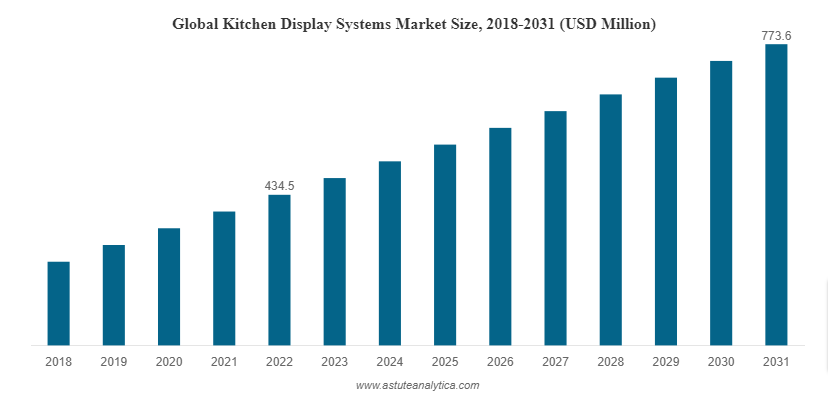The restaurant business in Saudi Arabia, where tradition meets modernity, the restaurant industry is always on the lookout for innovative solutions to enhance efficiency and customer satisfaction. One such groundbreaking innovation is the kitchen display system (KDS). But what exactly is a kitchen display system, and how can it revolutionize the way restaurants operate in the Kingdom? Let’s dive in.
What is a Kitchen Display System?
A kitchen display system, often abbreviated as KDS, is a digital solution that replaces traditional paper ticket systems in restaurants. Instead of handwritten or printed orders, chefs and kitchen staff view orders on digital screens, ensuring a streamlined and efficient process from the moment a customer places an order to the time it’s served.
The global kitchen display system market was valued at US$ 434.5 million in 2022 and is projected to reach a market valuation of US$ 773.6 million by 2031 at a CAGR of 6.62% during the forecast period from 2023 to 2031.

How Does a Kitchen Display System Work?
Imagine a bustling restaurant during peak hours. The traditional method involves waitstaff writing down orders and handing them over to the kitchen, which can lead to miscommunication or lost tickets. With a KDS system, the process is simplified:
- A customer places an order, either with a waiter or through a digital ordering platform.
- The order is instantly transmitted to the kitchen display system.
- Chefs and kitchen staff view the order details on the screen, complete with customization requests and special instructions.
- As dishes are prepared, they are marked as complete on the system, notifying the waitstaff or delivery personnel.
- The entire process is seamless, reducing wait times and minimizing errors.
8 Benefits of Restaurant Kitchen Display Systems
Restaurants always aim to work efficiently and make their customers happy. With new technology, they keep trying to get better and serve food in a better way. One new tool they are using is the Kitchen Display System (KDS). Let’s look at why KDS is so beneficial for them.
1. Streamlined Operations and Enhanced Efficiency
Traditional paper ticket systems can be cumbersome. Orders can get misplaced, handwriting can be misinterpreted, and the flow of orders can become chaotic during peak hours. With a KDS, orders are displayed digitally, ensuring a clear, organized, and efficient workflow. Chefs can easily see which orders are pending, which are in progress, and which are completed, allowing for a smoother kitchen operation.
2. Improved Order Accuracy
Miscommunication or misinterpretation of handwritten orders can lead to mistakes, resulting in dissatisfied customers and wasted resources. A KDS eliminates this problem by displaying orders clearly and concisely. Whether it’s a special dietary request or a dish modification, everything is presented unambiguously, ensuring that the dish prepared aligns perfectly with the customer’s request.
3. Faster Service and Reduced Wait Times
Time is of the essence in the restaurant business. With real-time order display, kitchen staff can immediately start preparing dishes, leading to significantly reduced preparation times. This efficiency ensures that customers receive their meals faster, enhancing their overall dining experience.
4. Eco-friendly Approach
By transitioning from paper tickets to digital displays, restaurants significantly reduce their paper usage. This not only cuts down on operational costs associated with constantly purchasing paper but also positions the restaurant as environmentally conscious, a trait that resonates with many modern diners.
5. Seamless Integration with POS Systems
Many KDS solutions can seamlessly integrate with Point of Sale (POS) systems. This integration ensures that the moment a waiter inputs an order into the POS, it’s instantly reflected on the kitchen display. Such synchronization eliminates the need for manual order transfers, further reducing the chances of human error.
6. Enhanced Kitchen Performance Metrics
Advanced KDS systems often come equipped with performance tracking features. Managers can gain insights into various metrics like average preparation time, dish popularity, and even individual chef performance. Such data is invaluable for making informed decisions, optimizing kitchen operations, and enhancing staff training programs.
7. Reduction in Operational Costs
While there’s an initial investment involved in setting up a KDS, the long-term benefits lead to cost savings. Reduced paper usage, minimized food wastage due to order inaccuracies, and optimized staff performance all contribute to a more cost-effective operation.
8. Improved Communication Between Front and Back of House
With a KDS, communication barriers between the waitstaff and the kitchen crew are broken down. When orders are ready, the system can notify the waitstaff, ensuring timely delivery to the customers. Any changes or cancellations are instantly reflected, ensuring both teams are always on the same page.
Conclusion
In the dynamic restaurant landscape of Saudi Arabia, staying ahead of the curve is crucial. Adopting a kitchen display system is not just a technological upgrade; it’s a strategic move to enhance efficiency, customer satisfaction, and overall restaurant performance. If you’re looking to elevate your restaurant’s operations, consider Talabat Menu’s kitchen display system – a solution designed with the modern Saudi restaurant in mind.

 English
English


